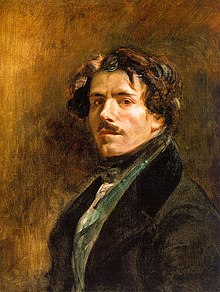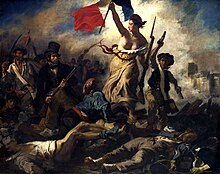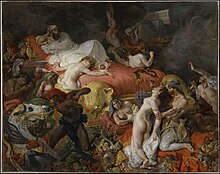Eugène Delacroix
Ferdinand Victor Eugène Delacroix [ ø.ʒɛn də.la.kʁwa ] (born April 26, 1798 in Charenton-Saint-Maurice , Paris , † August 13, 1863 in Paris) was a French painter . Because of the liveliness of his imagination and his generous use of colors, he is regarded as a pioneer of impressionism and every year he exhibited paintings in the Paris Salon whose passionate subjects caused a sensation and often shocked them.
The works of Delacroix are assigned to the French late romanticism , but he refused to be added to the popular trend of the romantic school . He became the model for many impressionists who decidedly differentiated themselves from the romantic school and classicism .
Life
Delacroix 'mother Victoire Œben (1758-1814) came from the cabinetmaker family Oeben , his father Charles-François Delacroix was a member of the revolutionary government and until 1797 foreign minister. He then worked as an ambassador in Holland . During this time Delacroix was born. There is, however, strong evidence that his father was in fact Charles Maurice de Talleyrand . This thesis is represented u. a. by Franz Blei , Alfred Duff Cooper, 1st Viscount Norwich , and Orieux. These authors refer to the physiognomic similarity of Talleyrand and Delacroix, the impossibility of biological paternity of Delacroix's nominal father, who was unable to procreate at the time of conception as a result of a venereal ailment - which was only remedied several months after conception the promotion of the young Delacroix by an anonymous but powerful and financially strong benefactor.
A few months after Charles-François Delacroix became Prefect of the Gironde department , the family moved to Bordeaux . His childhood was eventful, as Alexandre Dumas , a future friend, let posterity know. His musical talent was noticed at school. After Charles-François Delacroix died in 1805, the family moved back to Paris a few months later. Here Eugène Delacroix attended the Lycée Impérial , where he developed a penchant for literature. He spent his holidays in a Gothic monastery in Normandy that belonged to a cousin. He was so impressed by the ruins that he started painting. Encouraged by his uncle Jean-Henri Riesener , the two of them visited Pierre-Narcisse Guérin's studio from time to time . His mother died in 1814 and Eugène moved in with his sister. A year later he began studying in Guérin's studio. In 1816 he enrolled at the École nationale supérieure des beaux-arts de Paris .

Two years later, Delacroix observed Théodore Géricault working on the painting The Raft of Medusa . Disturbed by this experience, he painted the Dante bark , which refers to a scene from Dante Alighieri's major work Divine Comedy . He gave this work to the Salon for the annual art exhibition in 1822 - it was unconventional and attracted widespread attention. The French state acquired the picture and had it hung in the Palais du Luxembourg . At the age of 24 Delacroix left the École des Beaux-Arts. He began to keep a diary and to analyze himself and his environment and took part in discussions about art.
He was drawn to the romantics. Their ideas, thoughts and ideas are reflected in his second painting, The Massacre of Chios , which met with shared criticism. With this picture, its importance in the younger generation of painters could no longer be denied. He was considered the leading painter of Romanticism, even if he himself repeatedly denied this leading role.
Delacroix was now reading poems by Lord Byron and became interested in the theater. He particularly valued the dramas by William Shakespeare and Goethe's Faust . In 1827 he made 17 lithographs for Faust . In the same year he exhibited his picture The Death of Sardanapal , which appalled the critics. Many urged him not to waste his talent in such excesses. These voices fell silent in 1831 when he exhibited Freedom Leading the People to Glory and Commemoration of the July Revolution in the Salon. With this picture he consolidated his leading role among painters.


Influential friends made it possible for Delacroix to travel to Morocco and visit the local sultan. He could now see with his own eyes things that the romantics imagined in their imaginations. Delacroix was impressed by the radiant light, lush colors, and simple dignity of Islam. The hundreds of notes and sketches that he made during this period remained a constant source of inspiration. Studies on animals and, above all, his paintings on lion hunting are also an expression of this creative period.
On returning to France, the government commissioned him to create several paintings. This task occupied him until the end of his life. Because he worked non-stop for months, constantly making drafts and sketches and at the same time directing his employees, he had little free time. In the morning he found diversion in the salons, where his wit and intelligence were in demand. He had few real friends, including George Sand and Frédéric Chopin .
In old age Delacroix, who withdrew more and more, received great honors. A retrospective was dedicated to him at the World Exhibition of 1855 . He was also awarded the Grand Médaille d'Honneur, was commander of the Legion of Honor and in 1857 a member of the École des Beaux-Arts, to which he sent his last picture in 1859. Four years later he died of a chronic throat disease.
Pioneer of impressionism
Delacroix turned against the prevailing practice of the classicists of his time , who, for the sake of the plastic ideal, gave priority to the brightness values in painting and viewed the chromatic values of color as secondary. Delacroix shared the opinion of other romantics such as Turner that painting was thus deceiving itself of its very own means, the color values themselves. With their help, he determined the overall effect of the picture. According to the respective topic, he first put the colors together on the palette in order to influence the character of the work from the outset. In this way Delacroix achieved an enormous wealth of color differentiation.
Delacroix's style of painting also heralds Impressionism through the use of the optical mixture and the reflective colors, which are based on the precise observation of the changing light conditions .
Works (selection)


- Paris, Musée National du Louvre :
- The Dante Barque (1822)
- The Chios massacre (1824)
- Young Orphan in the Cemetery (1824)
- Still life with a lobster (1827)
- The death of Sardanapal (1827)
- Freedom leads the people (1830)
- Young tiger playing with his mother (1830)
- The women of Algiers (1834)
- Jewish wedding in Morocco (1837–41)
- The capture of Constantinople (1840)
- Don Juan's barge (1840)
- Bordeaux , Musée des beaux-arts:
- Basel, Kunstmuseum Basel :
- Wounded Bandit, Quenching His Thirst (around 1825)
- Budapest, Szépművészeti Múzeum :
- Horse startled by the storm (1824)
- Hamburg, Hamburger Kunsthalle :
- Lion and Alligator, 1863 , oil on oak 28.5 × 36 cm
- Tiger and Snake , 1858 Oil on paper mounted on wood 32.4 × 40.3 cm
- London, Wallace Collection :
- The execution of Doge Marino Faliero (1826)
- Prague, Národní gallery
- Rider attacked by a jaguar (1855)
- Saint Petersburg, Hermitage :
- Lion hunt in Morocco (1854)
- Stuttgart, New State Gallery Stuttgart :
- Indian woman torn by a tiger (1856)
- Washington, Phillips Collection :
- Horses Coming from the Sea (1860)
- Vienna, Belvedere :
- Still life with flowers (around 1834)

Famous students (selection)
Later honor
The French national bank issued 100 franc banknotes with his portrait from 1978 to 1995.
literature
- chronological -
- Philippe Burty (ed.): Lettres de Eugène Delacroix: 1815 à 1863 (1878) . First edition 1878; New edition Kessinger Publishing , Whitefish (Montana) 2010, ISBN 978-1-16018-331-4 .
- Paul-Henri Michel: Delacroix. The slaughter of Chios. Saar-Verlag, Saarbrücken and Éditions d'art Vendôme, Paris 1947.
- Daguerre de Hureau: Delacroix. The complete work. Belser Verlag, Stuttgart & Zurich 1994, ISBN 3-7630-2305-4 .
- Robert Floetemeyer: Delacroix 'image of man - explorations against the background of the art of Rubens . Zabern , Mainz 1998, ISBN 3-8053-2329-8 .
- Sabine Maria Schmidt / Marie-Christine Torre-Schäfer / Günter Busch : Eugène Delacroix. Exhibition catalog Kunsthalle Bremen . Hauschild, Bremen 1998, ISBN 978-3-931785-85-7 .
- Gilles Néret: Eugène Delacroix. 1798-1863. The king of the romantics . Taschen Verlag , Cologne u. a. 2004, ISBN 3-8228-1393-1 .
- Michael Brunner u. a. (Eds.): Géricault, Delacroix, Daumier and contemporaries. French lithographs and drawings. Exhibition catalog. Edited by Karin Althaus, Michael Mohr and Götz J. Pfeiffer. Imhof-Verlag, Petersberg 2009, ISBN 978-3-86568-403-5 .
- Reiner Zeeb: Goethe's new concept of France and the reception of Delacroix's lithographs for “Faust I” 1826/1828 . In: Kevin E. Kandt and H. Vogel von Vogelstein (eds.): From Hyppocrenes Quell. An album of amicorum art historical contributions on the occasion of Gerd-Helge Vogel's 60th birthday . Lukas Verlag , Berlin 2011, ISBN 978-3-86732-104-4 , pp. 116-135.
Reprinted in: Reiner Zeeb: Art Revolution and Form. Essays. Verlag Ludwig, Kiel 2017, ISBN 978-3-86935-309-8 , pp. 141-160.
Movie
- Eugène Delacroix - A painter in a frenzy of colors. (OT: Eugène Delacroix, d'Orient et d'Occident. ) Documentary with game scenes, France, 2018, 90 min., Book: Jean-Frédérique Thibault and Arnaud Xainte, director: Arnaud Xainte, production: arte France, Illégitime Défense, 2 M Maroc, Saga Film, first broadcast: April 1, 2018 on arte, synopsis by ARD . On Delacroix's six-month trip to Morocco in 1832 and its effect on his painting.
Web links
- Works by Eugène Delacroix at Zeno.org, images from 188 paintings and 35 drawings
- Literature by and about Eugène Delacroix in the catalog of the German National Library
- Works by and about Eugène Delacroix in the German Digital Library
- Eugène Delacroix (1798–1863) on assemblee-nationale.fr (French)
- Overview of some works on ibiblio.org (English)
- Faust illustrations on goethezeitportal.de
- Eugène Delacroix at Google Arts & Culture
Individual evidence
- ↑ Peter H. Feist: French Impressionism , p. 24.
- ^ W. Nerdinger (Ed.): Perspektiven der Kunst , Munich, Oldenbourg, 2002.
| personal data | |
|---|---|
| SURNAME | Delacroix, Eugène |
| ALTERNATIVE NAMES | Delacroix, Ferdinand Victor Eugène (full name) |
| BRIEF DESCRIPTION | French painter |
| DATE OF BIRTH | April 26, 1798 |
| PLACE OF BIRTH | Charenton-Saint-Maurice , Paris |
| DATE OF DEATH | August 13, 1863 |
| Place of death | Paris |



